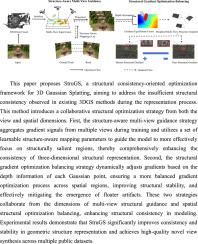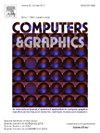StruGS: Structurally consistent 3D Gaussian Splatting with targeted optimization strategies
IF 2.8
4区 计算机科学
Q2 COMPUTER SCIENCE, SOFTWARE ENGINEERING
引用次数: 0
Abstract
This paper proposes StruGS, a structural consistency-oriented optimization framework for 3D Gaussian Splatting, aiming to address the insufficient structural consistency observed in existing 3DGS methods during the representation process. This method introduces a collaborative structural optimization strategy from both the view and spatial dimensions. First, the structure-aware multi-view guidance strategy aggregates gradient signals from multiple views during training and utilizes a set of learnable structure-aware mapping parameters to guide the model to more effectively focus on structurally salient regions, thereby comprehensively enhancing the consistency of three-dimensional structural representation. Second, the structural gradient optimization balancing strategy dynamically adjusts gradients based on the depth information of each Gaussian point, ensuring a more balanced gradient optimization process across spatial regions, improving structural stability, and effectively mitigating the emergence of floater artifacts. These two strategies collaborate from the dimensions of multi-view structural guidance and spatial structural optimization balancing, enhancing structural consistency in modeling. Experimental results demonstrate that StruGS significantly improves consistency and stability in geometric structure representation and achieves high-quality novel view synthesis across multiple public datasets.

StruGS:结构一致的三维高斯溅射与目标优化策略
针对现有三维高斯溅射方法在表示过程中结构一致性不足的问题,提出了面向结构一致性的三维高斯溅射优化框架StruGS。该方法从视图和空间两个维度引入协同结构优化策略。首先,结构感知多视图引导策略在训练过程中聚合来自多个视图的梯度信号,利用一组可学习的结构感知映射参数,引导模型更有效地关注结构显著区域,从而全面增强三维结构表征的一致性。其次,结构梯度优化平衡策略根据每个高斯点的深度信息动态调整梯度,确保跨空间区域的梯度优化过程更加均衡,提高结构稳定性,有效缓解浮子伪影的出现。这两种策略从多视角结构引导和空间结构优化平衡两个维度协同工作,增强了建模中的结构一致性。实验结果表明,StruGS显著提高了几何结构表示的一致性和稳定性,实现了跨多个公共数据集的高质量新视图合成。
本文章由计算机程序翻译,如有差异,请以英文原文为准。
求助全文
约1分钟内获得全文
求助全文
来源期刊

Computers & Graphics-Uk
工程技术-计算机:软件工程
CiteScore
5.30
自引率
12.00%
发文量
173
审稿时长
38 days
期刊介绍:
Computers & Graphics is dedicated to disseminate information on research and applications of computer graphics (CG) techniques. The journal encourages articles on:
1. Research and applications of interactive computer graphics. We are particularly interested in novel interaction techniques and applications of CG to problem domains.
2. State-of-the-art papers on late-breaking, cutting-edge research on CG.
3. Information on innovative uses of graphics principles and technologies.
4. Tutorial papers on both teaching CG principles and innovative uses of CG in education.
 求助内容:
求助内容: 应助结果提醒方式:
应助结果提醒方式:


